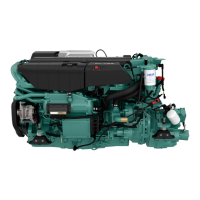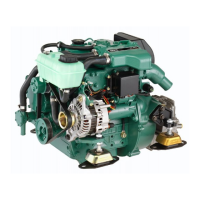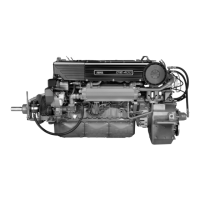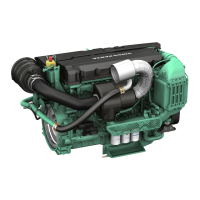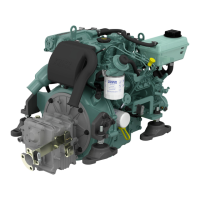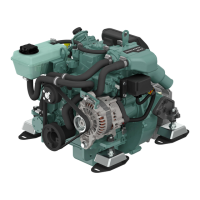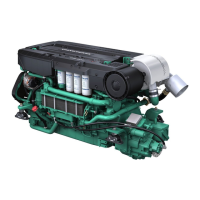Do you have a question about the Volvo Penta D11/IPS20 and is the answer not in the manual?
Defines safety text priority and symbol meanings for hazard communication.
Covers safe handling of chemicals and daily visual engine checks.
Details essential personal protective equipment for engine operation and maintenance.
Advises on skin care, fire prevention, and safe disposal of used oils and chemicals.
Covers preventing engine start, ventilation, and awareness of hot/rotating parts.
Outlines safety measures for electrical work and welding near the engine.
Details safety procedures for cooling system work and refueling operations.
Emphasizes proper fuel use and safe handling of batteries to prevent hazards.
Provides guidelines for battery compartment design, cleaning, and clutch adjustment safety.
Covers safe maneuvering practices and accident prevention at sea, including stern turbulence.
Lists essential pre-trip checks, safety equipment, and spare parts recommendations.
Explains the purpose and scope of the Operator's Manual for optimal benefit.
Details the engine's limited warranty, terms, and conditions.
Advises on learning boat handling, safety, and regulations for new owners.
Guides on the proper running-in period for new engines to ensure longevity.
Specifies the correct types of fuel, oils, and coolant for engine maintenance.
Emphasizes using genuine parts and authorized dealers for optimal service and reliability.
Warns against applying external loads to engine and transmission components.
Advises on maintaining EVC system integrity and the risks of using non-genuine parts.
Details the installation and safe operation of the Volvo Penta External Helm system.
Highlights Volvo Penta's focus on energy efficiency and low emissions.
Explains how engine data is recorded and its usage policy by Volvo Penta.
Outlines special care requirements for emission-certified engines to maintain compliance.
Describes the global dealer network for service, repair, and parts.
Explains the phone-based breakdown and support service available 24/7.
Details how to use the ignition lock and e-Key panel for system access.
Explains the e-Key panel functionality and managing system keys.
Describes the e-Key remote's features for locking, unlocking, and starting the engine.
Introduces the various Volvo Penta control panels and their configurable functionality.
Explains the use of the Start/Stop panel for engine ignition and shutdown.
Details how to activate and adjust cruise control settings.
Describes the functions available on the Sport Fish Panel for fishing modes.
Explains how to activate, start/stop engines, and manage messages using the docking panel.
Covers adjusting display contrast and panel backlighting for optimal visibility.
Describes how fault messages are displayed and acknowledged.
Explains the tachometer's function for engine speed and displays engine hours.
Describes the fuel level gauge indicating remaining fuel.
Details the voltmeter for showing alternator charge current and battery voltage.
Explains the gauge for monitoring engine coolant temperature.
Describes the oil pressure gauge and normal operating ranges.
Details the sensor indicating fresh water level in the tank.
Explains the instrument showing rudder position.
Describes the alarm monitor providing visual warnings for active alarms.
Explains the information display showing engine data, messages, and alarms.
Guides on accessing and navigating the settings menu for system configuration.
Describes how fault messages are presented and acknowledged on the display.
Explains how to adjust the display's backlighting for optimal viewing.
Introduces the 4" display as an optional control system supplement.
Details how to use the panel buttons to navigate and control the 4" display.
Lists available screens in the 4" display for viewing operational data.
Introduces the 7" display for viewing and controlling all system functions.
Details using the knob and buttons for navigating the 7" display menus.
Explains customizing the 'My View' screen with analog or digital instruments.
Introduces the Independent Rudder System as an aid for maneuvering and mooring.
Details how to enter settings menus and navigate the IRS display.
Covers adjusting display dimming and selecting day/night modes.
Explains the SDM's role in protecting the engine from damage via automatic shutdown.
Details the automatic circuit breakers on the engine and how to reset them.
Explains the automatic circuit breaker for the IPS unit and its reset.
Explains the control levers for twin engine speed and gear shift.
Explains how to disengage the gearshift function to operate only the throttle.
Guides on adjusting the control lever's friction brake for movement stiffness.
Introduces the Lowspeed function for reducing speed at low engine revolutions.
Details the steps to activate the Lowspeed function.
Explains how to switch off the Lowspeed function.
Describes the Autopilot's function in maintaining boat steering and course.
Provides essential safety notices and operational guidelines for autopilot use.
Introduces the joystick for docking and steering, emphasizing safe practice.
Outlines the requirements and steps for activating the joystick docking mode.
Explains how to deactivate the joystick docking function.
Details how to engage and activate the autopilot system.
Guides on setting a course using autopilot arrow buttons and step size.
Explains the need for a connected plotter for GPS steering functionality.
Guides on using the 'Route to' function to follow set routes with the autopilot.
Details various GPS pattern steering modes like Orbit, Cloverleaf, and Search.
Covers setting the display mode to Day or Night for visibility.
Explains the Shadow Drive feature and its automatic reactivation.
Details setting the degree increment for course changes in autopilot.
Notes that dealer-specific settings require authorized dealer adjustment.
Covers system settings for course reference, declination, and operating position.
Explains how to revert settings to factory defaults and reset calibration.
Lists connected NMEA 2000 units.
Introduces the DPS system for holding position and heading via GPS.
Emphasizes operator responsibility and safety precautions during DPS activation.
Discusses factors affecting DPS performance and recommendations for optimal use.
Warns about maintaining safe distances and potential interference affecting DPS.
Introduces DPS repositioning for adjusting anchored position using the joystick.
Provides step-by-step instructions for performing DPS repositioning.
Introduces Assisted Docking as a supplementary aid for boat maneuvering.
Highlights safety precautions and operator responsibilities during Assisted Docking.
Discusses factors affecting Assisted Docking performance and proximity warnings.
Introduces the ACP system for IPS unit corrosion protection and its protection levels.
Explains ACP mode settings, chlorine-free mode, and battery usage.
Details the steps for engaging the engine for power take-off use.
Explains how to disconnect the engine from power take-off.
Introduces the interceptor system for trim control and improved passage.
Explains manual interceptor control using lever and panel buttons.
Details how interceptor blade position is shown on the EVC display.
Explains the automatic self-cleaning process for interceptor blades.
Introduces the trailing pump system for IPS units in triple/quad installations.
Details the steps for starting the trailing pumps via display units.
Explains how to stop the trailing pumps using display or control unit key.
Introduces Easy Connect for boat and engine data via smartphone/tablet.
Emphasizes visual checks of engine, bay, and transmission before starting.
Recommends engine/bay heaters for temperatures below +5°C to reduce smoke.
Warns against using start spray due to explosion risk.
Provides a checklist of essential pre-start actions and important notices.
Explains how helm stations activate and become active for engine control.
Details the starter motor circuit's protection against overheating.
Instructs to put the gear in neutral before starting the engine.
Emphasizes safe handling of engine, controls, and avoiding sudden maneuvers.
Warns about the danger of rotating propellers and proximity to water.
Guides on reading instruments and alarm displays during operation.
Details how to read, acknowledge, and address alarms.
Explains shifting procedures at idling speeds and the impact of high-speed shifts.
Guides on executing forward and reverse operations safely.
Details how to activate a helm station for control.
Provides critical warnings about disconnecting power and turning off ignition before main switches.
Details the procedure for stopping engines using the Start/Stop panel.
Explains how to stop engines and lock the EVC system using the e-Key panel.
Describes the automatic ignition turn-off feature and its settings.
Details checks for leakages, closing taps, and turning off power after shutdown.
Guides on trimming stern drives for protection or specific situations.
Advises on the timing for switching off the main power to save engine data.
Recommends warming up the engine periodically when the boat is not used.
Details draining systems and ensuring freeze protection for cold weather.
Advises checking battery charge status to prevent freezing.
Explains how faults trigger alarms and the diagnostic function's role.
Details how different malfunction severities affect engine operation.
Lists possible causes and corrective actions for corrosion status faults.
Covers issues related to low battery voltage and corrective actions.
Details faults related to control lever operation and fault acknowledgment.
Lists engine faults affecting performance and corrective actions.
Covers EVC system communication and control panel failures.
Details joystick failure issues and corrective actions.
Outlines safety functions activated during faults like engine start failure or shutdown.
Advises on operating the boat at low speed if engines fail or reduce power.
Discusses handling faults in triple engine installations and low-speed operation.
Explains the importance of following service intervals for reliability and warranty.
Discusses conditions for extending engine oil change intervals.
Covers safety precautions before starting maintenance work on the engine.
Details general inspection points for the engine and engine bay.
Provides step-by-step instructions for replacing the engine air filter.
Guides on checking and topping up the engine oil level safely.
Emphasizes cleanliness during refueling and notes injector work by authorized workshops.
Warns about fire hazards when working on the fuel system.
Advises on safe storage of fuel-soaked rags to prevent fires.
Details coolant composition, OAT technology, and mixing recommendations.
Guides on checking, cleaning, and replacing zinc anodes.
Provides instructions for checking and changing the seawater pump impeller.
Explains how to clean and maintain the seawater filter to prevent overheating.
Describes the 2-pole electrical system and safety warnings for working on it.
Explains the function of the main switch and safety precautions for its use.
Details the automatic circuit breakers on the engine and how to reset them.
Explains the automatic circuit breaker for the IPS unit and its reset.
Guides on checking electrical connections for dryness, oxide, and tightness.
Provides critical warnings about battery handling risks and electrolyte hazards.
Advises on ventilating the compartment before working on batteries.
Covers battery maintenance, charging, and extending service life.
Warns about potential leakage current from incorrect electrical installations.
Provides safety guidelines for low voltage circuits and shore power connections.
Emphasizes proper cable routing and ground protection for equipment.
Details requirements for main switches on start and auxiliary batteries.
Outlines safety measures for welding near electrical systems and components.
Describes the electronically controlled hydraulic clutch and its control.
Explains galvanic corrosion protection and optional active corrosion protection.
Details regular checks and replacement of sacrificial anodes for corrosion protection.
Explains the process of removing and securing new anodes.
Covers replacing the zinc anode integrated into the ACP unit.
Explains regularly checking seawater and exhaust cocks for proper function.
Warns about engine start safety during propeller work and ignition removal.
Advises on prompt replacement of damaged propellers and cautious operation.
Explains the process of long-term preservation for the engine and propulsion unit.
Provides a checklist of important points for long-term storage.
Lists maintenance tasks for engines when the boat is stored in water.
Details maintenance tasks applicable whether the boat is in or out of water.
Lists maintenance tasks specifically for when the boat is out of the water.
Warns about using high pressure washers near seals and electrical components.
Advises on disconnecting and charging batteries for storage.
Explains how to navigate and manage settings and calibrations in the menu.
Guides on adapting the information shown in the main menu to personal preferences.
Explains how to enable or disable the audible signal for the neutral position.
Explains the crucial calibration of the water-in-oil sensor for new engines and after oil changes.
Guides on setting the depth alarm level and parameters on echo sounders.
Explains how to set depth compensation values for accurate depth display.
Describes how depth alarm messages and audible signals are presented.
Details the multipoint method for precise fuel tank level calibration.
Explains the approximate full fuel tank calibration method.
Notes that volume, empty tank, and alarm settings require a Volvo Penta workshop.
Guides on adjusting the speed factor to match GPS data for accurate speed display.
Details the procedure for adding a new key to the system.
Explains how to remove existing keys from the system.
Provides technical data for different engine models (IPS-650, IPS-800, IPS-950).
States the freshwater system capacity including the heat exchanger.
Details coolant composition, OAT technology, and mixing recommendations.
Provides system voltage and specifications for the AC generator.
Details specifications for alternative generator equipment.
States battery capacity and electrolyte density at +25°C.
Details oil capacity, volume difference, and recommended oil quality for the propulsion unit.
States the gear ratio for the propulsion unit.
Explains how to find and record engine identification numbers from type plates.
Details how to find and record propulsion unit identification numbers.
Explains how to find and record identification numbers for the rudder actuator.
Defines safety text priority and symbol meanings for hazard communication.
Covers safe handling of chemicals and daily visual engine checks.
Details essential personal protective equipment for engine operation and maintenance.
Advises on skin care, fire prevention, and safe disposal of used oils and chemicals.
Covers preventing engine start, ventilation, and awareness of hot/rotating parts.
Outlines safety measures for electrical work and welding near the engine.
Details safety procedures for cooling system work and refueling operations.
Emphasizes proper fuel use and safe handling of batteries to prevent hazards.
Provides guidelines for battery compartment design, cleaning, and clutch adjustment safety.
Covers safe maneuvering practices and accident prevention at sea, including stern turbulence.
Lists essential pre-trip checks, safety equipment, and spare parts recommendations.
Explains the purpose and scope of the Operator's Manual for optimal benefit.
Details the engine's limited warranty, terms, and conditions.
Advises on learning boat handling, safety, and regulations for new owners.
Guides on the proper running-in period for new engines to ensure longevity.
Specifies the correct types of fuel, oils, and coolant for engine maintenance.
Emphasizes using genuine parts and authorized dealers for optimal service and reliability.
Warns against applying external loads to engine and transmission components.
Advises on maintaining EVC system integrity and the risks of using non-genuine parts.
Details the installation and safe operation of the Volvo Penta External Helm system.
Highlights Volvo Penta's focus on energy efficiency and low emissions.
Explains how engine data is recorded and its usage policy by Volvo Penta.
Outlines special care requirements for emission-certified engines to maintain compliance.
Describes the global dealer network for service, repair, and parts.
Explains the phone-based breakdown and support service available 24/7.
Details how to use the ignition lock and e-Key panel for system access.
Explains the e-Key panel functionality and managing system keys.
Describes the e-Key remote's features for locking, unlocking, and starting the engine.
Introduces the various Volvo Penta control panels and their configurable functionality.
Explains the use of the Start/Stop panel for engine ignition and shutdown.
Details how to activate and adjust cruise control settings.
Describes the functions available on the Sport Fish Panel for fishing modes.
Explains how to activate, start/stop engines, and manage messages using the docking panel.
Covers adjusting display contrast and panel backlighting for optimal visibility.
Describes how fault messages are displayed and acknowledged.
Explains the tachometer's function for engine speed and displays engine hours.
Describes the fuel level gauge indicating remaining fuel.
Details the voltmeter for showing alternator charge current and battery voltage.
Explains the gauge for monitoring engine coolant temperature.
Describes the oil pressure gauge and normal operating ranges.
Details the sensor indicating fresh water level in the tank.
Explains the instrument showing rudder position.
Describes the alarm monitor providing visual warnings for active alarms.
Explains the information display showing engine data, messages, and alarms.
Guides on accessing and navigating the settings menu for system configuration.
Describes how fault messages are presented and acknowledged on the display.
Explains how to adjust the display's backlighting for optimal viewing.
Introduces the 4" display as an optional control system supplement.
Details how to use the panel buttons to navigate and control the 4" display.
Lists available screens in the 4" display for viewing operational data.
Introduces the 7" display for viewing and controlling all system functions.
Details using the knob and buttons for navigating the 7" display menus.
Explains customizing the 'My View' screen with analog or digital instruments.
Introduces the Independent Rudder System as an aid for maneuvering and mooring.
Details how to enter settings menus and navigate the IRS display.
Covers adjusting display dimming and selecting day/night modes.
Explains the SDM's role in protecting the engine from damage via automatic shutdown.
Details the automatic circuit breakers on the engine and how to reset them.
Explains the automatic circuit breaker for the IPS unit and its reset.
Explains the control levers for twin engine speed and gear shift.
Explains how to disengage the gearshift function to operate only the throttle.
Guides on adjusting the control lever's friction brake for movement stiffness.
Introduces the Lowspeed function for reducing speed at low engine revolutions.
Details the steps to activate the Lowspeed function.
Explains how to switch off the Lowspeed function.
Describes the Autopilot's function in maintaining boat steering and course.
Provides essential safety notices and operational guidelines for autopilot use.
Introduces the joystick for docking and steering, emphasizing safe practice.
Outlines the requirements and steps for activating the joystick docking mode.
Explains how to deactivate the joystick docking function.
Details how to engage and activate the autopilot system.
Guides on setting a course using autopilot arrow buttons and step size.
Explains the need for a connected plotter for GPS steering functionality.
Guides on using the 'Route to' function to follow set routes with the autopilot.
Details various GPS pattern steering modes like Orbit, Cloverleaf, and Search.
Covers setting the display mode to Day or Night for visibility.
Explains the Shadow Drive feature and its automatic reactivation.
Details setting the degree increment for course changes in autopilot.
Notes that dealer-specific settings require authorized dealer adjustment.
Covers system settings for course reference, declination, and operating position.
Explains how to revert settings to factory defaults and reset calibration.
Lists connected NMEA 2000 units.
Introduces the DPS system for holding position and heading via GPS.
Emphasizes operator responsibility and safety precautions during DPS activation.
Discusses factors affecting DPS performance and recommendations for optimal use.
Warns about maintaining safe distances and potential interference affecting DPS.
Introduces DPS repositioning for adjusting anchored position using the joystick.
Provides step-by-step instructions for performing DPS repositioning.
Introduces Assisted Docking as a supplementary aid for boat maneuvering.
Highlights safety precautions and operator responsibilities during Assisted Docking.
Discusses factors affecting Assisted Docking performance and proximity warnings.
Introduces the ACP system for IPS unit corrosion protection and its protection levels.
Explains ACP mode settings, chlorine-free mode, and battery usage.
Details the steps for engaging the engine for power take-off use.
Explains how to disconnect the engine from power take-off.
Introduces the interceptor system for trim control and improved passage.
Explains manual interceptor control using lever and panel buttons.
Details how interceptor blade position is shown on the EVC display.
Explains the automatic self-cleaning process for interceptor blades.
Introduces the trailing pump system for IPS units in triple/quad installations.
Details the steps for starting the trailing pumps via display units.
Explains how to stop the trailing pumps using display or control unit key.
Introduces Easy Connect for boat and engine data via smartphone/tablet.
Emphasizes visual checks of engine, bay, and transmission before starting.
Recommends engine/bay heaters for temperatures below +5°C to reduce smoke.
Warns against using start spray due to explosion risk.
Provides a checklist of essential pre-start actions and important notices.
Explains how helm stations activate and become active for engine control.
Details the starter motor circuit's protection against overheating.
Instructs to put the gear in neutral before starting the engine.
Emphasizes safe handling of engine, controls, and avoiding sudden maneuvers.
Warns about the danger of rotating propellers and proximity to water.
Guides on reading instruments and alarm displays during operation.
Details how to read, acknowledge, and address alarms.
Explains shifting procedures at idling speeds and the impact of high-speed shifts.
Guides on executing forward and reverse operations safely.
Details how to activate a helm station for control.
Provides critical warnings about disconnecting power and turning off ignition before main switches.
Details the procedure for stopping engines using the Start/Stop panel.
Explains how to stop engines and lock the EVC system using the e-Key panel.
Describes the automatic ignition turn-off feature and its settings.
Details checks for leakages, closing taps, and turning off power after shutdown.
Guides on trimming stern drives for protection or specific situations.
Advises on the timing for switching off the main power to save engine data.
Recommends warming up the engine periodically when the boat is not used.
Details draining systems and ensuring freeze protection for cold weather.
Advises checking battery charge status to prevent freezing.
Explains how faults trigger alarms and the diagnostic function's role.
Details how different malfunction severities affect engine operation.
Lists possible causes and corrective actions for corrosion status faults.
Covers issues related to low battery voltage and corrective actions.
Details faults related to control lever operation and fault acknowledgment.
Lists engine faults affecting performance and corrective actions.
Covers EVC system communication and control panel failures.
Details joystick failure issues and corrective actions.
Outlines safety functions activated during faults like engine start failure or shutdown.
Advises on operating the boat at low speed if engines fail or reduce power.
Discusses handling faults in triple engine installations and low-speed operation.
Explains the importance of following service intervals for reliability and warranty.
Discusses conditions for extending engine oil change intervals.
Covers safety precautions before starting maintenance work on the engine.
Details general inspection points for the engine and engine bay.
Provides step-by-step instructions for replacing the engine air filter.
Guides on checking and topping up the engine oil level safely.
Emphasizes cleanliness during refueling and notes injector work by authorized workshops.
Warns about fire hazards when working on the fuel system.
Advises on safe storage of fuel-soaked rags to prevent fires.
Details coolant composition, OAT technology, and mixing recommendations.
Guides on checking, cleaning, and replacing zinc anodes.
Provides instructions for checking and changing the seawater pump impeller.
Explains how to clean and maintain the seawater filter to prevent overheating.
Describes the 2-pole electrical system and safety warnings for working on it.
Explains the function of the main switch and safety precautions for its use.
Details the automatic circuit breakers on the engine and how to reset them.
Explains the automatic circuit breaker for the IPS unit and its reset.
Guides on checking electrical connections for dryness, oxide, and tightness.
Provides critical warnings about battery handling risks and electrolyte hazards.
Advises on ventilating the compartment before working on batteries.
Covers battery maintenance, charging, and extending service life.
Warns about potential leakage current from incorrect electrical installations.
Provides safety guidelines for low voltage circuits and shore power connections.
Emphasizes proper cable routing and ground protection for equipment.
Details requirements for main switches on start and auxiliary batteries.
Outlines safety measures for welding near electrical systems and components.
Describes the electronically controlled hydraulic clutch and its control.
Explains galvanic corrosion protection and optional active corrosion protection.
Details regular checks and replacement of sacrificial anodes for corrosion protection.
Explains the process of removing and securing new anodes.
Covers replacing the zinc anode integrated into the ACP unit.
Explains regularly checking seawater and exhaust cocks for proper function.
Warns about engine start safety during propeller work and ignition removal.
Advises on prompt replacement of damaged propellers and cautious operation.
Explains the process of long-term preservation for the engine and propulsion unit.
Provides a checklist of important points for long-term storage.
Lists maintenance tasks for engines when the boat is stored in water.
Details maintenance tasks applicable whether the boat is in or out of water.
Lists maintenance tasks specifically for when the boat is out of the water.
Warns about using high pressure washers near seals and electrical components.
Advises on disconnecting and charging batteries for storage.
Explains how to navigate and manage settings and calibrations in the menu.
Guides on adapting the information shown in the main menu to personal preferences.
Explains how to enable or disable the audible signal for the neutral position.
Explains the crucial calibration of the water-in-oil sensor for new engines and after oil changes.
Guides on setting the depth alarm level and parameters on echo sounders.
Explains how to set depth compensation values for accurate depth display.
Describes how depth alarm messages and audible signals are presented.
Details the multipoint method for precise fuel tank level calibration.
Explains the approximate full fuel tank calibration method.
Notes that volume, empty tank, and alarm settings require a Volvo Penta workshop.
Guides on adjusting the speed factor to match GPS data for accurate speed display.
Details the procedure for adding a new key to the system.
Explains how to remove existing keys from the system.
Provides technical data for different engine models (IPS-650, IPS-800, IPS-950).
States the freshwater system capacity including the heat exchanger.
Details coolant composition, OAT technology, and mixing recommendations.
Provides system voltage and specifications for the AC generator.
Details specifications for alternative generator equipment.
States battery capacity and electrolyte density at +25°C.
Details oil capacity, volume difference, and recommended oil quality for the propulsion unit.
States the gear ratio for the propulsion unit.
Explains how to find and record engine identification numbers from type plates.
Details how to find and record propulsion unit identification numbers.
Explains how to find and record identification numbers for the rudder actuator.
| Gearbox Model | IPS20 |
|---|---|
| Type | Diesel |
| Displacement | 10.8 liters |
| Bore | 123 mm |
| Stroke | 152 mm |
| Aspiration | Turbocharged |
| Max Torque | 2500 Nm |
| Fuel System | Common rail |
| Cooling System | Freshwater cooled |
| Emissions Compliance | IMO Tier II, EPA Tier 3 |
| Engine Model | Volvo Penta D11 |
